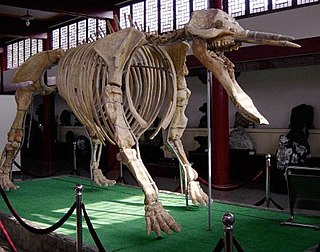 W
WAmebelodontidae is an extinct family of large herbivorous mammals that were closely related to elephants. They were formerly assigned to Gomphotheriidae, but recent authors consider them a distinct family.
 W
WAmebelodon is a genus of extinct proboscidean belonging to Amebelodontidae, a group of proboscideans related to the modern elephants and their close relative the mammoth. The most striking attribute of this animal is its lower tusks, which are narrow, elongated, and distinctly flattened with the degree of flattening varying among the different species. Two valid species are currently placed within this genus, which was endemic to North America. Other species once assigned to Amebelodon are now assigned to the genus Konobelodon, which was once a subgenus.
 W
WArchaeobelodon is an extinct genus of proboscidean of the family Amebelodontidae that lived in Europe and North Africa (Egypt) during the Miocene from 16.9—16.0 Ma, living for approximately 0.9 million years.
 W
WKonobelodon is a genus of amebelodont from southern Europe, China, and North America.
 W
WPlatybelodon was a genus of large herbivorous mammals related to the elephant. It lived during the middle Miocene Epoch in Africa, Asia and the Caucasus.
 W
WProgomphotherium is an extinct genus of large herbivorous mammals that were closely related to elephants.
 W
WSerbelodon is an extinct genus of proboscidean. It had tusks and a trunk. It lived in North America during the Miocene Epoch, and it was closely related to Amebelodon. They had a diet that consisted of C3 plants which include fruits, tree cortex, herbs, and leaves.